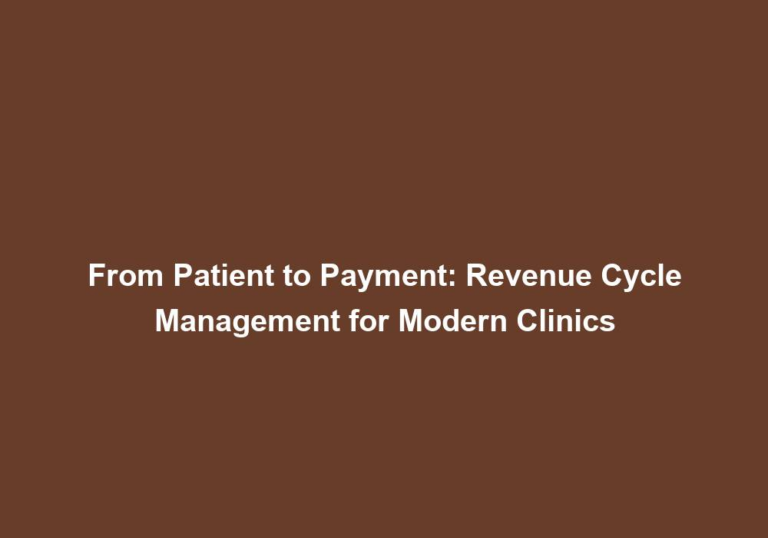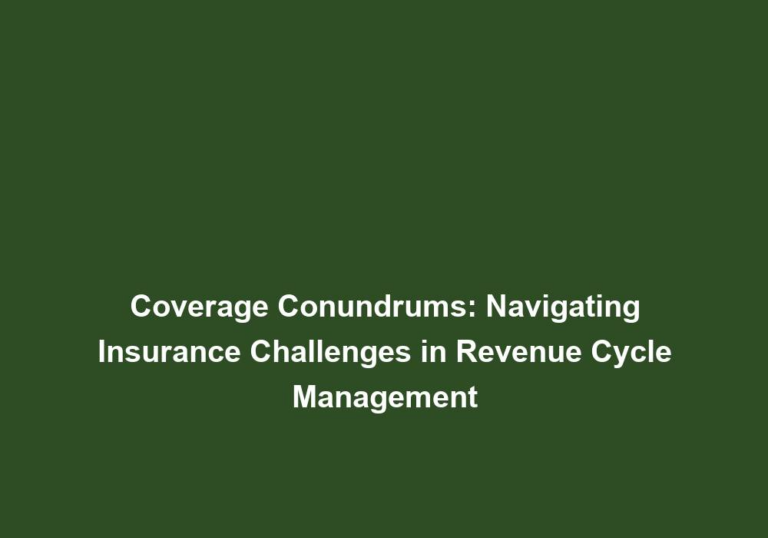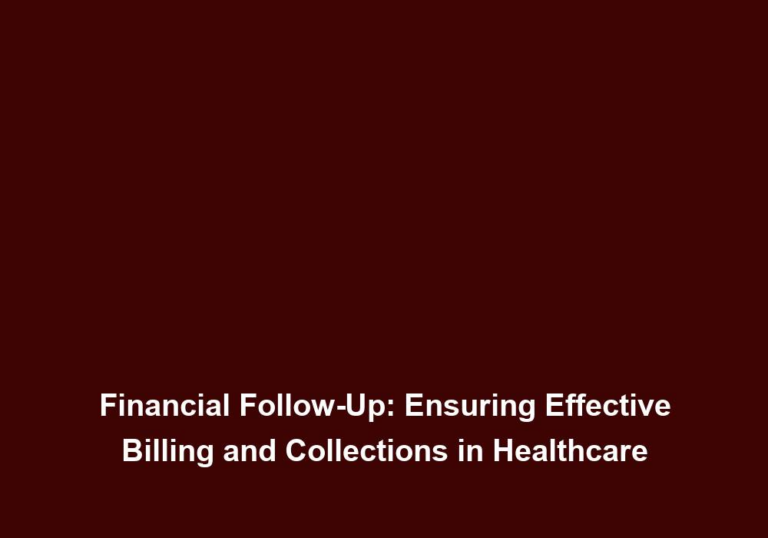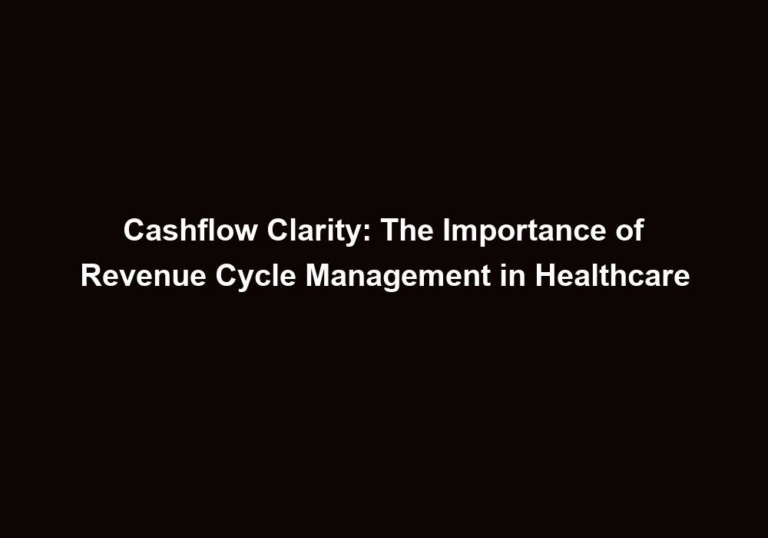Financial Follow-Up: Ensuring Effective Billing and Collections in Healthcare
In the realm of healthcare, it is vital to establish efficient billing and collections processes to maintain the financial stability of healthcare organizations. With the constantly evolving landscape of medical reimbursements and insurance regulations, healthcare providers must be well-versed in the intricacies of financial follow-up. This article aims to provide insights and strategies for optimizing billing and collections in the healthcare industry.
Importance of Financial Follow-Up in Healthcare
Financial follow-up is the backbone of revenue cycle management in healthcare. It encompasses the activities performed after a patient’s visit, which includes coding, billing, claim submission, and collections. Effective financial follow-up ensures that healthcare providers receive appropriate reimbursement for the services they provide, which in turn supports the sustainability and growth of the organization.
To understand the importance of financial follow-up, it’s crucial to recognize the impact it has on the overall financial health of healthcare organizations. Here are a few key reasons why financial follow-up is essential:
-
Revenue Maximization: A robust financial follow-up process ensures that healthcare providers receive the maximum reimbursement for the services rendered. By effectively managing coding, billing, and claim submission, organizations can avoid claim denials and optimize revenue generation.
-
Cash Flow Management: Financial follow-up plays a vital role in managing the cash flow of healthcare organizations. Timely billing, accurate coding, and efficient collections processes contribute to a steady cash flow, allowing organizations to meet their financial obligations and invest in growth opportunities.
-
Compliance with Regulations: The healthcare industry is heavily regulated, and compliance with billing and collections regulations is critical. Effective financial follow-up ensures adherence to regulatory guidelines and minimizes the risk of legal and financial penalties.
-
Sustainability and Growth: By optimizing billing and collections, healthcare organizations can maintain financial stability and support their long-term sustainability. Adequate reimbursement enables organizations to invest in advanced technologies, hire skilled staff, and expand their services, ultimately leading to growth and improved patient care.
Understanding the Revenue Cycle
Before delving into the specifics of billing and collections, it is crucial to grasp the entire revenue cycle in healthcare. The revenue cycle begins when a patient seeks medical services and concludes with the full payment of the outstanding balance. It can be divided into several stages, including patient registration, verification of insurance coverage, coding and charge capture, claim submission, payment posting, denial management, and collections.
Each stage of the revenue cycle is interconnected and requires meticulous attention to detail to ensure a smooth flow of financial transactions. Let’s explore each stage in more detail:
-
Patient Registration: This initial stage involves collecting patient demographic and insurance information. Accurate and complete registration is essential to verify insurance coverage, determine patient eligibility, and initiate the billing process.
-
Verification of Insurance Coverage: Before providing services, healthcare providers must verify the patient’s insurance coverage and determine the benefits and limitations. This step ensures that the services rendered are eligible for reimbursement and prevents claim denials due to coverage issues.
-
Coding and Charge Capture: Accurate coding is crucial for billing and reimbursement. Healthcare providers must assign the appropriate codes to reflect the services provided, ensuring compliance with coding guidelines. Proper charge capture, which involves capturing fees for services rendered, is also essential for accurate billing.
-
Claim Submission: Once coding and charge capture are complete, healthcare organizations submit claims to insurance payers for reimbursement. Claims should be accurately completed, including all necessary documentation and supporting information, to avoid rejections or delays in payment.
-
Payment Posting: After the insurance payer processes the claim, healthcare organizations receive payments. Payment posting involves recording and reconciling payments received, identifying any discrepancies, and updating patient accounts accordingly.
-
Denial Management: Claim denials are inevitable in the healthcare industry. Effective denial management involves analyzing denial patterns, identifying root causes, and implementing corrective actions to prevent their recurrence. Timely follow-up and communication with payers are essential to resolve denials and expedite reimbursement.
-
Collections: If a patient’s outstanding balance remains unpaid after insurance reimbursement, healthcare organizations must engage in collections activities. This stage may involve sending reminders, offering payment plans, or working with collection agencies to recover the outstanding balance.
Understanding the revenue cycle helps healthcare organizations identify areas for improvement and implement strategies to optimize billing and collections processes at each stage.
Optimizing Billing Processes
To streamline the billing process and minimize the risk of denied claims, healthcare organizations should consider implementing the following strategies:
-
Accurate Documentation: Ensuring accurate and detailed documentation of patient encounters, procedures, and diagnoses is essential for successful billing. Clear documentation supports correct coding and minimizes the risk of claim denials. Healthcare providers should emphasize the importance of complete and precise documentation to their staff and provide training on proper documentation practices.
-
Proper Coding: Proper coding is crucial for accurate billing and reimbursement. Healthcare providers should stay updated with the latest coding guidelines and ensure that their coders are proficient in assigning the appropriate codes. Regular audits and coding training can help identify and rectify any coding errors, reducing claim rejections. Implementing technology solutions that automate coding processes can also enhance accuracy and efficiency.
-
Claim Scrubbing: Before submitting claims, organizations should invest in claim scrubbing software or services to identify potential errors or missing information. Claim scrubbers help catch issues such as incomplete patient information, incorrect codes, or missing documentation before claims are sent, reducing the chances of denials. Regularly reviewing and refining claim scrubbing processes can further improve billing accuracy.
-
Timely Claim Submission: Prompt claim submission is vital to avoid delays in reimbursement. Establishing a well-defined process for claim submission and monitoring claim turnaround times can expedite the revenue cycle and minimize the risk of late payments. Healthcare organizations should prioritize efficient claim submission by leveraging technology solutions that automate claim submission processes and provide real-time status updates.
By implementing these strategies, healthcare organizations can optimize their billing processes, reduce claim denials, and improve overall revenue cycle performance.
Effective Collections Strategies
Optimizing collections processes is equally important for healthcare organizations to maintain a healthy cash flow. Below are some strategies that can enhance collections:
-
Clear Financial Policies: Establishing clear and transparent financial policies is crucial to ensure patients understand their financial responsibilities. Clearly communicate payment expectations, insurance coverage details, and available payment options to patients at the time of service or before. Providing written materials or online resources that outline the financial policies can also help in setting clear expectations.
-
Proactive Patient Communication: Regularly communicating with patients about their outstanding balances, payment options, and potential financial assistance programs can facilitate timely payments. Implementing automated reminders via email, text, or phone can help improve patient engagement and increase collections. Personalized communication, such as follow-up calls or personalized letters, can also be effective in addressing specific patient concerns and encouraging prompt payment.
-
Offering Flexible Payment Options: Providing patients with flexible payment options, such as payment plans or online payment portals, can alleviate financial burdens and encourage prompt payments. Offering electronic payment options can also enhance convenience for patients and streamline the collection process. Healthcare organizations should actively promote and educate patients about the available payment options to increase utilization.
-
Effective Denial Management: Robust denial management processes are crucial to identify and address claim denials promptly. Analyze denial patterns, identify root causes, and implement corrective actions to prevent their recurrence. Timely and proactive follow-up with payers can help resolve denials and expedite reimbursement. Leveraging technology solutions that automate denial management workflows and provide real-time analytics can improve the efficiency of denial resolution.
By implementing these collections strategies, healthcare organizations can improve their collections rates, reduce accounts receivable aging, and maintain a healthy cash flow.
Utilizing Technology for Seamless Financial Follow-Up
Leveraging technology can significantly enhance the efficiency and effectiveness of financial follow-up in healthcare. Consider integrating the following technologies into your billing and collections processes:
-
Electronic Health Records (EHR): EHR systems streamline documentation, coding, and claim submission processes. They improve accuracy, reduce administrative burdens, and provide a centralized platform for seamless data exchange between healthcare providers and payers. EHRs also enable the integration of clinical and financial data, facilitating comprehensive patient care and revenue cycle management.
-
Revenue Cycle Management (RCM) Software: RCM software automates and streamlines billing, coding, claim submission, and collections processes. It provides real-time analytics and reporting, enabling organizations to identify bottlenecks, track key performance indicators, and optimize revenue cycle outcomes. RCM software also integrates with other healthcare systems, such as EHRs and practice management software, to create a cohesive workflow.
-
Telehealth Solutions: Telehealth platforms enable remote patient consultations and electronic billing, eliminating geographical barriers and enhancing patient access to care. By incorporating telehealth into your practice, healthcare providers can expand their reach, increase patient volume, and improve billing efficiency. Telehealth solutions often integrate with billing and collections systems, simplifying the financial follow-up process for virtual visits.
By embracing technology solutions tailored to the needs of healthcare organizations, providers can streamline financial follow-up processes, reduce administrative burdens, and improve overall revenue cycle performance.
Conclusion
In conclusion, effective billing and collections are integral components of healthcare financial management. By implementing strategies such as accurate documentation, proper coding, and timely claim submission, healthcare organizations can optimize their billing processes and minimize claim denials. Additionally, clear financial policies, proactive patient communication, and flexible payment options can enhance collections. Leveraging technology, such as EHR systems, RCM software, and telehealth solutions, further strengthens the financial follow-up process. By prioritizing financial follow-up, healthcare organizations can ensure financial stability and provide quality care to their patients.







